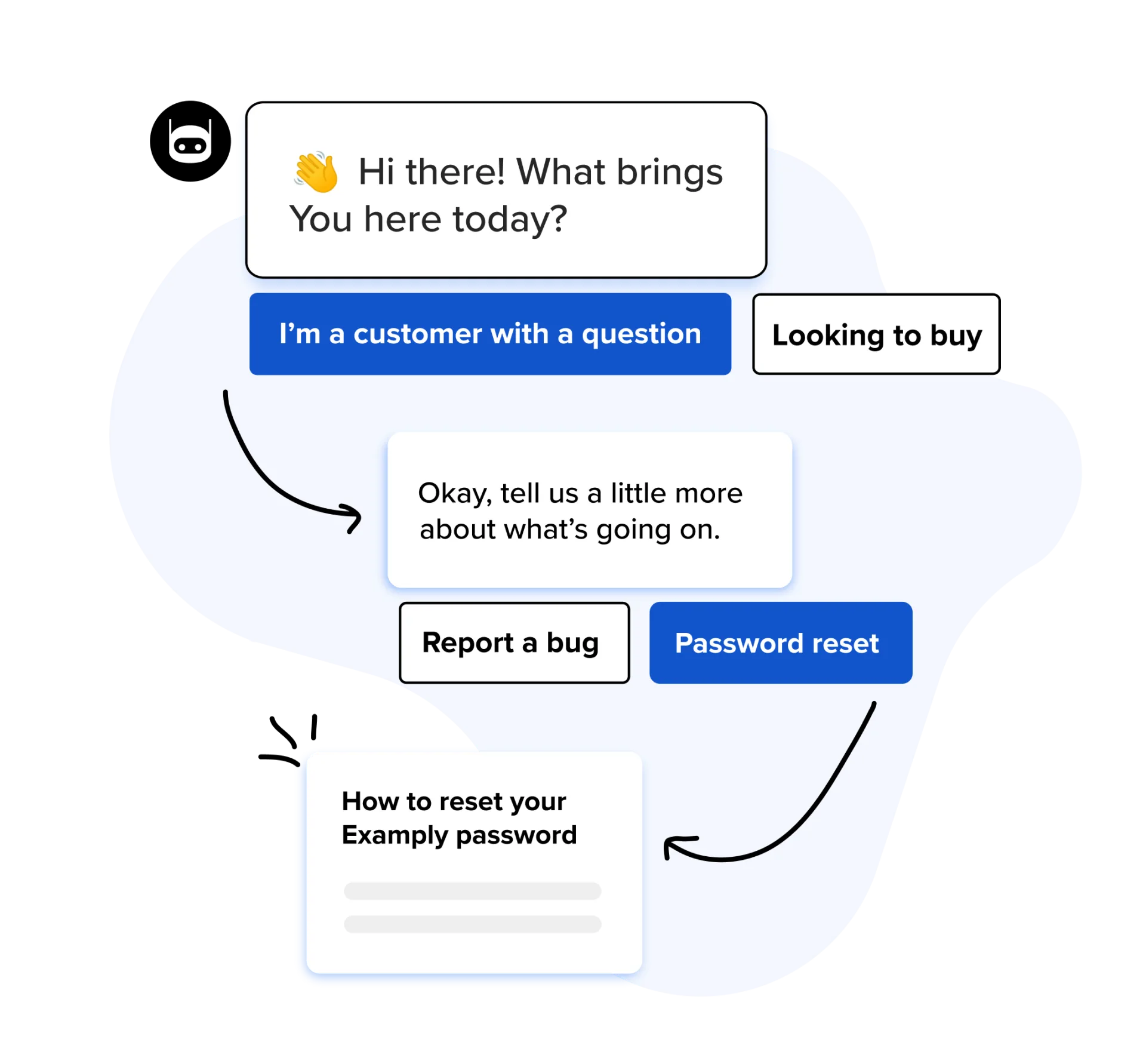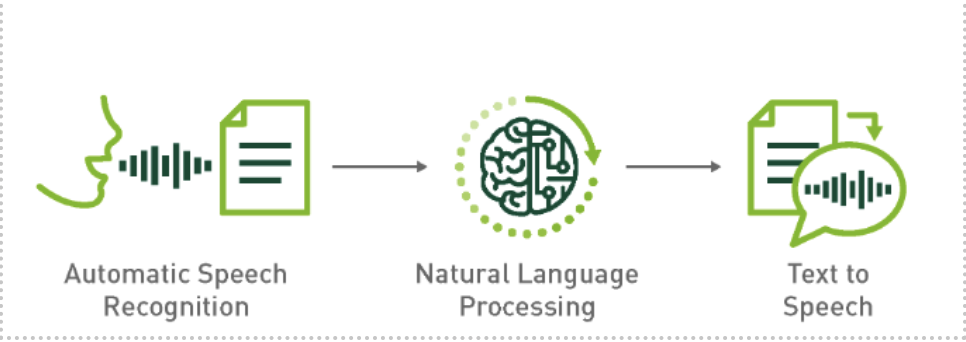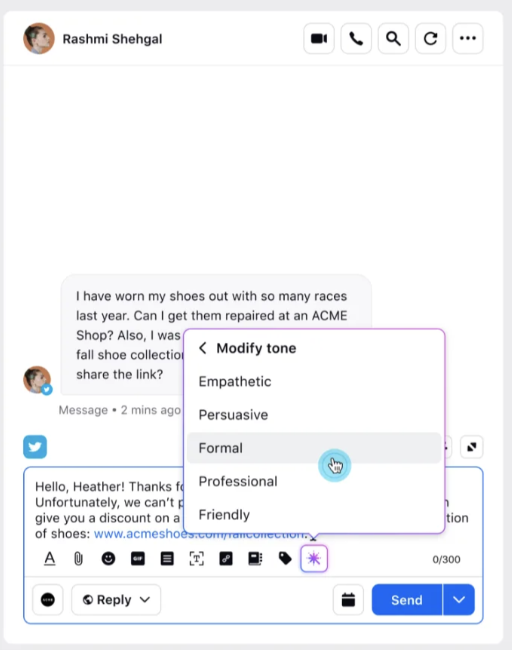Bots working with human agents is how AI in customer service looks. While the customer service agent helps the customer, a bot helps the agent find better solutions. The latest AI statistics indicate that as many as 300 million full-time jobs worldwide could be automated in some way by the newest wave of artificial intelligence – generative AI. Agent augmentation and support automation emerge as the top impact areas of AI in customer service.
Even though Jarvis isn’t a reality, Alexa is, and AI has some intriguing use cases in customer service like AI-augmented human customer service, organizing email inquiries, enhanced support calls, automated appointment setting and visual recognition support. Before we discuss these use cases, let’s understand what AI in customer service is.
- What is AI in customer service?
- Key benefits of artificial intelligence in customer service
- 4 Key uses of AI in customer service for businesses
- 1. AI-supported human customer service
- 2. AI-organized email inquiries
- 3. AI-enhanced call management
- 4. Visual recognition for product support
- How to integrate artificial intelligence and customer service
- An exemplary implementation of AI-based customer service
What is AI in customer service?
Customer service is a crucial aspect of any business, encompassing the support and assistance provided to customers before, during and after a purchase.
AI (Artificial Intelligence) in customer service refers to the use of AI to enhance and improve customer service. Organizations leverage AI systems to automate and augment various customer service tasks and interactions by deploying technologies like:
Predictive analytics
Natural language processing (NLP)
Agent assistance
Key benefits of artificial intelligence in customer service
The role of customer service in fostering positive customer experiences is undisputed. The integration of customer service and AI opens incredible opportunities to enhance the customer experience even further by enabling businesses and support teams to:
📚Handle large volumes of data
AI swiftly analyzes vast customer data, empowering businesses to gain profound insights that escape the naked eye. By utilizing the analysis power of AI, you can extract information from siloed customer touchpoints, process raw data into actionable insights and detect patterns in customer behavior, market trends and recurring issues.
⏰Reduce average handling times (AHT)
Implementing AI, including chatbots and voice biometrics, streamlines customer interactions and reduces your average handling time (AHT). Chatbots provide immediate responses, while voice biometrics significantly reduce user verification time, ensuring swift issue resolution.
Interesting read: 3 Bolts of Wisdom for Lightning-fast Customer Response Times
👕😀Personalize experiences and offerings
AI creates unique customer profiles by collating structured and unstructured interactions between brands and customers across siloed touchpoints. Brands can then use these profiles for targeted marketing, sales and support, creating hyper-personalized offerings that make customers feel heard and valued.
💵Become cost-efficient
AI proves to be a cost-saving powerhouse by automating tasks and identifying areas of inefficiency, optimizing operations and maximizing returns on investment.
📈Track and improve support quality
AI-powered quality management simplifies performance tracking, offering comprehensive insights into team and agent efficiency. AI-powered dashboards facilitate customer service metrics monitoring, agent scoring and individualized coaching recommendations that drive a culture of continuous improvement.

4 Key uses of AI in customer service for businesses
AI has the potential to improve customer service in many ways. Combining AI's efficiency with human agents' empathy and problem-solving skills can result in a more comprehensive customer experience. AI in customer service can be leveraged in four main ways.
1. AI-supported human customer service
By leveraging AI in conjunction with human agents, businesses can create a seamless transition towards a more optimized customer service system. With AI to handle simple tasks like case management and call routing, human agents can focus on complex queries and relationship building. AI augments human customer service by:
Maintaining context: AI systems provide agents with context by retrieving customer information quickly. For example, they can scour your CRM, sales and marketing records to quickly retrieve information about previous customer interactions or purchase histories so agents can pick up the conversation from where it was left.
💡Pro tip: For best results, use omnichannel chatbots that can recall customer information from all the channels a customer has used during their brand journey. This way, your customer need not repeat their story every time, which goes a long way in enhancing their brand experience.
Answering routine queries independently: By redirecting routine questions to FAQ chatbots and other self-serve tools, AI reduces your call inflow drastically, which lightens your agents’ caseload and improves resolution time.

Intelligent routing: With AI at your support front end, customer queries are filtered and routed to the agent/team with the right skill set to solve them efficiently. AI also assesses your agents’ availability and workload before assigning them cases – giving your overworked support teams a welcome respite.

Timely recommendations: An AI-powered knowledge base can serve your agents with the right content and product recommendations during calls. This allows agents instant access to relevant information, such as product details or troubleshooting steps.
2. AI-organized email inquiries
Managing and comprehending every email received by a company can be a time-consuming task when relying solely on human effort. To expedite this process, companies can leverage AI to:
Scan and tag emails, ensuring they are directed to the appropriate department for timely resolutions.
Auto-suggest responses that have appealed to the customer in the past.
Clean inboxes of spam and promotional messages that take your agents away from answering critical messages.
All in all, AI-powered email tools offer the capability to expedite your email customer support, delighting customers with prompt, personalized and well-timed emails.
3. AI-enhanced call management
AI is harder to deploy for voice-based communications. On a purely technical level, it is more challenging for a computer system to deal with voice than chat, as one needs to overcome challenges like background noise, unusual speech patterns, accents and poor pronunciation.
Then why bother?
Because call centers are still the go-to choice for customer support. When it comes to complex financial and technical questions, customers show a three-to-one preference for phone calls in such scenarios. Despite challenges, AI-first companies have successfully utilized AI to enhance the capabilities of their call center representatives by leveraging speech analytics and other call center technologies.

The process begins with capturing the user's spoken input with AI filtering out background noise using neural networks that can differentiate between the message and ambient sounds.
Once the input is captured, AI-driven voice bots, trained on NLP and natural language understanding (NLU) models, identify the intent of the message, taking into account industry-specific use cases.
After narrowing down potential responses, the voice bot selects the most accurate and objective solution for the customer's inquiry, which is converted into an audio format using a text-to-speech system, allowing the voice bot to provide the answer audibly.
4. Visual recognition for product support
By analyzing images or videos, these systems swiftly identify and comprehend product-related issues. This advanced technology allows customers to visually convey their concerns, enabling a more intuitive and efficient troubleshooting process.
Through accurate recognition algorithms, customers receive visual instructions for problem resolution, empowering them to address issues independently. This not only enhances the overall customer experience but also reduces the reliance on textual descriptions, making support more accessible.
Curious to learn more? Here is the complete list of AI Examples in Customer Support.
How to integrate artificial intelligence and customer service
Integrating artificial intelligence (AI) into customer service using technologies like Machine Learning and Computer Vision can significantly enhance efficiency and customer satisfaction. Below is a seven-step process to do it.
Understand data types
Data comes from various sources like interactions, transactions and feedback, encompassing text, images, videos and numerical values. They are classified into three types.Structured data, like customer satisfaction scores (CSAT) and analytics, is efficiently analyzed by data analytics software, aiding informed decision-making processes.
Unstructured data, such as audio, video and open-ended responses, lacks a predetermined framework, posing a challenge for traditional analysis methods due to its diverse nature.
Semi-structured data, exemplified by CRM messages blending structured elements with unstructured content, demands a nuanced analytical approach due to its flexible organizing principle.
Perform data structuring and labeling
Ensure data is well-structured before feeding it into AI models. Utilize tools to clean and format data appropriately. Label data according to relevant categories like demographics, product name and purchase history to train the AI model effectively.Best practices of data collection for AI-led customer service
The proverb "garbage in, garbage out" holds true for data. Ensure the data fed into the model is of high quality. Validate and clean data to remove inconsistencies, ensuring accurate model training and reliable insights.
Do's:
Prioritize quality over quantity: Emphasize accurate and relevant data, prioritizing quality over sheer volume to avoid diluting the effectiveness of AI models.
Ensure data privacy compliance: Adhere to data privacy regulations and implement robust security measures to protect customer information.
Don'ts:
Avoid biased sampling: Steer clear of biased data collection methods to prevent skewed insights that could perpetuate discriminatory practices or inaccuracies.
Refrain from over-collection: Resist the temptation to collect excessive data beyond what is necessary for the defined objectives, as it can lead to increased storage costs and potential misuse of sensitive information.
Build support-specific intents
Building support-specific intents for AI in customer service is a nuanced process and needs thorough query analysis for the identification of common themes and recurring issues. Thereafter, specific intents for key topics have to be built and aligned with a typical customer journey.💡Pro Tip: Advanced platforms like Sprinklr AI+ come with pre-built intents from 150+ industries, so you can skip all these steps and take your AI to market quickly.
Train the AI model on your proprietary data
Training the AI model on proprietary data involves a strategic and meticulous process to ensure optimal performance.Focus on feature engineering and identify pertinent features within the proprietary dataset that align with desired outcomes in customer service.
Divide the dataset into training and validation sets, with a larger portion allocated for training to enable the model to learn intricate patterns and relationships within the data accurately.
Select a suitable pre-trained AI model architecture tailored to the nature of customer service tasks. Adapt it to the organization's specific context through the application of transfer learning techniques.
Involve human review in the training process to validate model predictions. Address false positives/negatives and refine the model accordingly.
5. Integrate the AI model with your workflows
Once the AI model is trained, integrate it with existing workflows in customer service.
Implement a data management system that ensures a seamless flow, organizing and processing customer queries efficiently. Explore technologies like chatbots or live chat features to facilitate prompt and effective responses to customer queries. Integrate decision-making automation into customer service workflows, enhancing efficiency and responsiveness based on AI-generated insights.
6. Test and update AI models regularly
Conducting comprehensive testing for AI interfaces involves two key aspects.
From the agent's perspective, usability tests are conducted to assess functionalities like query handling and data access. It is essential to evaluate agent feedback on interface intuitiveness and identify bottlenecks.
In customer-facing interface testing, users assess query initiation and response clarity. Feedback on customer comfort and understanding of AI features is collected and bugs/friction points are identified for further refinement.
An exemplary implementation of AI-based customer service
Combining the power of AI with human expertise results in a customer service approach that is both efficient and responsive. Just like what happened with Planet Fitness.
Planet Fitness, a leading fitness franchise, aimed to deliver a top-notch customer experience across its 2,400+ locations in 50 US states. Managing social presence, customer service and brand reputation posed a significant challenge. As each agent covered as many as 3,000 cases a month, the Planet Fitness team wanted to lighten the burden by building a system for high-quality interactions, improving customer experience.
Solution: In 2020, Planet Fitness partnered with Sprinklr, leveraging its unified platform for social media management. The introduction of Sprinklr AI+ in June 2023 marked a pivotal solution. AI+ acted as a personal assistant, enhancing customer service quality, response times and social listening insights.
Example: With AI+ in action, social media care reps tailored responses effortlessly, ensuring appropriateness in length and detail. The "Make it Longer," "Make it Shorter," and "Reword" features saved time and personalized responses. Modifying tone became seamless, allowing representatives to adapt to various channels, from the casual vibe of TikTok to the professionalism of Google reviews.

Sprinklr AI+ not only lightened the burden on reps but also empowered Reputation Manager Kara Seymour. Seymour utilized AI+ for advanced social listening queries, enhancing the understanding of customer sentiments in real time.
Outcome The positive impact of Sprinklr AI+ was significant. Representatives delivered thoughtful and effective responses, ensuring personalized interaction rather than robotic ones. Metrics tracked daily response numbers, highlighting the balance achieved between speed and quality. Sprinklr AI+ became an integral part of Planet Fitness's strategy, elevating the overall customer experience.
“AI+ acts like a personal assistant, allowing our social media care reps to have meaningful conversations, while ensuring we're being consistent in messaging, tone, character count for certain channels, etc. AI provides suggestions, but we maintain full control of community engagement and social listening reports."

Kara Seymour
Reputation Manager
Planet Fitness
Want to elevate your business in 2024 just like Planet Fitness did with Sprinklr AI+? Request a free trial today.
Frequently Asked Questions






